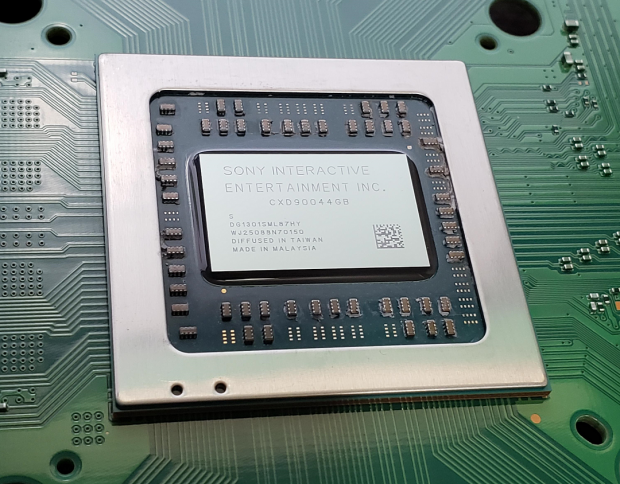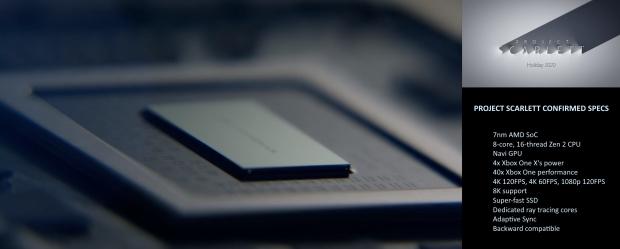When the PlayStation 5 and Project Scarlett next-gen consoles roll out in 2020, developers will be making games across seven different platforms (eight platforms including PC). Will last-gen systems hold the beastly Zen 2, Navi-powered consoles back?

2020 doesn't mark a true new generation of gaming. Rather than flipping the reset switch and making users buy all new games and accessories, Sony and Microsoft are launching a next-gen/iterative cycle hybrid. The new PS5 and Project Scarlett systems will deliver a big power leap over current consoles like a true next-gen ladder step, but they'll also support older-gen games and accessories like an iterative cycle does.
Throughout the next few years next-gen will share games with last-gen. Newer systems will basically join their respective families as the bigger, stronger older brother. In this overlap transition period, developers will be making games across seven consoles and eight platforms total:
- Xbox One
- Xbox One S
- Xbox One X
- Project Scarlett
- PC (Microsoft)
- PlayStation 4
- PlayStation 4 Pro
- PlayStation 5
As the lines get increasingly blurred, that means developers now have a smattering of systems to make their games compatible with. The hardware disparity between last- and next-gen is a blessing for newer games optimized for PS5 and Project Scarlett, but obviously the older consoles won't leverage real-time raytracing, super-fast loading times, and the potent 8-Core, 16-Thread Zen 2 CPU and Navi GPU combo.
The PlayStation 5 will be backward compatible with PS4 games, and Microsoft's next-gen Project Scarlett will play four generations' worth of Xbox games, all the way from the original Xbox to Xbox One.
Thankfully, the move to x86 architecture will be a tremendous asset for this cross-gen support, and both Sony and Microsoft are putting lots of effort into seamless transitions.

Read Also: ReRAM could be PS5, Project Scarlett's secret SSD sauce
The scaling isn't the potential issue here. Microsoft has an incredibly flexible and powerful Xbox SDK that allows one game to be scaled across multiple platforms, and we'll likely see some form of the Xbox One X's Intelligent Delivery system used. The possible issue is that new games will have to be developed with older last-generation hardware in mind.
Microsoft devs in particular will have to make games playable and optimized on all Xbox One consoles as well as PC, especially since all first-party Xbox games will be released on PC now too.
Microsoft in particular loves supporting last-gen hardware and games via backward compatibility initiatives, meaning it could be years before they're ready to move on and focus primarily on Project Scarlett. Forward compatibility won't be an option, but new games will likely release on Project Scarlett with optimizations to leverage the hardware, hinting at a repeat of the current Xbox One X Enhanced-style updates and upgrades.
Sony also won't just forsake the PlayStation 4 any time soon.
With over 100 million units sold worldwide, the PS4 is much, much too valuable to throw away as a platform--for both devs and Sony. The company confirmed the PS4 will live alongside the PlayStation 5 for roughly 2-3 years after launch. During this period, devs will have to optimize their games for three separate PlayStation systems--PS4, PS4 Pro, and the beefy PlayStation 5.
How much of a potential issue this turns out to be depends entirely on what tools and software Sony and Microsoft provide to developers, and how flexible the next-gen systems turn out to be.
The companies aren't stupid, and they know this could be a big roadblock to true next-gen console potential. Sure, first-party devs will have a major advantage because they work so closely to Sony and Microsoft (look at how Forza 7 was able to hit native 4K 60FPS on Xbox One X, for example), but both Sony and Microsoft are likely rolling out specialized SDKs to ensure proper backward- and forward-compatibility.
This kind of transition does make you wonder if next-gen will be held back by current-gen or not. There's major advantages with hybridizing the iterative cycle refresh model with next-gen hardware--for one, you don't have to reset everything and force everyone to buy new games--but also disadvantages too, like having to support all previous systems with new games.
Sony will probably be the one to eventually sunset the PS4 in 2022 or thereabouts and make new PlayStation games only playable on PS5 systems. Whether or not that's wise remains to be seen. Microsoft, on the other hand, probably won't follow that path until 3-5 years because of its dedication to cross-platform play.
Sony is expected to reveal the PS5 in a special event in February 2020. The console will release in Holiday 2020, and it may cost $499.
Check below for more info:
PlayStation 5 specs and details:
- Custom SoC with second-gen Navi GPU, Zen 2 8-core, 16 thread CPU
- Navi, Zen SoC uses new AMD RDNA 2.0 architecture
- Ultra-fast SSD
- Support for 4K 120 Hz TVs
- Ray-tracing enabled
- 8K graphics support (probably video, not gaming)
- Plays all PS4 games
- Separate games that ship on BD-XL Blu-ray discs
- New controller with extensive haptic and tactile feedback
PlayStation 5 Coverage:
- PS5, Xbox Scarlett SSD may use Optane-like ReRAM to supercharge speeds
- NVIDIA G-Sync monitors to improve PlayStation 5 and Xbox Scarlett
- PlayStation 5: Everything We Know So Far
- PlayStation 5 confirmed to have 8C/16T Zen 2 CPU from AMD
- PS5, Project Scarlett may use Samsung's 6th gen V-NAND NVMe SSDs
- PS5 backward compatibility confirmed, will play PS4 games
- Sony's next-gen PlayStation 5 has 4K 120Hz output support
- PS5, Project Scarlett to hit over 10TFLOPs of power, sources say
- PS4 will be supported into 2022, to live alongside PS5
- Sony: ultra-high-speed SSD is 'the key' to next-gen PS5
- PS5 dev kit rumor: 'ultra-fast RAM', Navi GPU with 13 TFLOPs
- PlayStation 5 rumored to ship with 2TB of super-fast SSD for $499
- Insider: PlayStation 5 dev kit faster than Xbox Scarlett right now
- PS5 cartridges aren't real, patents are for Sony kids toys
- PS5's SSD may benefit PS4 games the most
- PS5 powered by Navi in 2020, AMD making Navi with Sony input
- Cloud-powered PlayStation controller may let you play free game demos
- Gran Turismo 7 is a PlayStation 5 launch title: launches Nov 20, 2020
- PS5 confirmed to support 8K video, ray tracing, all on Navi
- PlayStation 5 rumored to cost $499, launches November 20, 2020
- PlayStation game demos are coming back with Sony's ambitious new plan
- PS5 controller: Built-in mic, USB-C, no lightbar, ergonomic design
- PlayStation 5 concept video shows totally new design
- Sony solves PS5's biggest issue
- Sony: PS5 development going according to plan
- New Viking Assassin's Creed may be next-gen console launch game
- AMD working on 'secret sauce' for next-gen Xbox/PlayStation
- The first real photo of a PlayStation 5 dev kit appears
- Next-gen PS5/Xbox Scarlett open-world game: 'best real-time graphics'
- Sony restructures workforce to prepare for PS5
- PlayStation VR 2: built-in cameras, wireless, ready for PS5
- PS5 games will ship on 100GB Blu-ray BDXL discs
- PS5 and Xbox Scarlett will both handle ray tracing differently
- PlayStation 5 could feature AI-powered 'PlayStation Assist'
- Sony won't abandon singleplayer story-driven games on PS5
- PS5 rumor: GPU is nearly as powerful as RTX 2080, GPU clocked at 2GHz
- PlayStation 5 rumored to be unveiled on February 12, 2020
- Sony to raise PS5 cost thanks to U.S. tariffs
Project Scarlett is due out by Holiday 2020. No pricing has been announced.
Check below for confirmed specs and details, and a huge content listing of everything we've heard about Project Scarlett so far:
Project Scarlett confirmed details:
- 8-core, 16-thread Zen 2 CPU
- Navi GPU
- Highly customized 7nm SoC from AMD
- GDDR6 memory
- 4x as powerful as the Xbox One X's 6TFLOPs of perf
- Can deliver up to 40x more performance than Xbox One in specific use cases
- Adaptive sync supported
- Super-fast SSD that can be used as VRAM
- Supports 8K resolution (likely media playback)
- 120FPS gaming
- Variable refresh rate
- Raytracing confirmed with dedicated raytracing cores
- Backward compatible with Xbox, Xbox 360, and Xbox One games
- Compatible with Xbox One accessories
Project Scarlett coverage:
- PS5, Xbox Scarlett SSD may use Optane-like ReRAM to supercharge speeds
- NVIDIA G-Sync monitors to improve PlayStation 5 and Xbox Scarlett
- Project Scarlett won't get VR gaming, Microsoft doesn't care about VR
- Next-gen Xbox Scarlett plays four generations of Xbox games
- Microsoft teases next-gen Xbox: 8K, 120FPS, super-fast SSD
- Xbox Scarlett CPU: 'no compromises', allows for 4K 120FPS gaming
- Microsoft: Xbox Scarlett will kick PlayStation 5's ass in perf/price
- Next-gen Xbox may hit 4K 60FPS in every game
- Project Scarlett to hit 1080p 120FPS gaming
- Project Scarlett trade-in program announced, but there's a big catch
- New Viking Assassin's Creed may be next-gen console launch game
- Next-gen Xbox may get room-scale VR gaming
- PS5 and Xbox Scarlett will both handle ray tracing differently
- Gears 5 developer says Xbox Scarlett has dedicated ray tracing cores
- GTA 6 on PS5, Project Scarlett to have insane hyper-realistic visuals
- AMD 'Flute': Xbox Scarlett SoC: Zen 2 8C/16T @ 3.2GHz on 7nm
- Project Scarlett's price isn't locked in yet
- Project Scarlett isn't the last Xbox console

